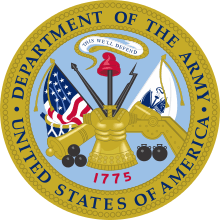
United States Army
The United States Army (USA) is the largest branch of the United States Armed Forces and performs land-based military operations. It is one of the seven uniformed services of the United States, and is designated as the Army of the United States in the United States Constitution, Article 2, Section 2, Clause 1 and United States Code, Title 10, Subtitle B, Chapter 301, Section 3001. As the largest and senior branch of the U.S. military, the modern U.S. Army has its roots in the Continental Army, which was formed (14 June 1775) to fight the American Revolutionary War (1775–83)—before the U.S. was established as a country. After the Revolutionary War, the Congress of the Confederation created the United States Army on 3 June 1784, to replace the disbanded Continental Army. The United States Army considers itself descended from the Continental Army, and dates its institutional inception from the origin of that armed force in 1775.

United States Army No. 101
US Army 101 is a 2-8-0 steam locomotive that was originally operated by the United States Army. It is one of two survivors of the 1,500 General Pershing locomotives built in 1916–1918 for the War Department in World War I. The 101 went on to see action in three wars — World War I, World War II, and the Korean War.
History
The history of the 101 is something of a mystery. Is known is that it was built for the US Army for use in World War I by Baldwin Locomotive Works. It was owned by the US Army until it was donated to Korea in 1947 - after the end of the Japanese occupation (1945) and prior to the start of the Korean War (1950).
In 1953, the 101 was recovered from damaged areas and reconstructed by the Army Transportation Corps, under the direction of Col. George Simpson. It seems that the 101 was still property of the Korean Republic, however. Col. George Simpson, Harold T.I. Shannon, and Harold E. Fuller started to talk with the Korean Republic about donating the engine to the National Railroad Museum.
Podcasts:
Latest News for: us army
‘Hid in narrow pit’: Karnataka man reveals how he survived Pahalgam terror attack
Hindustan Times 27 Apr 2025Campgrounds and visitor centres at federal lakes are closing amid Trump's budget cuts
The Times of India 27 Apr 2025Campgrounds and visitor centers at federal lakes are closing amid Trump’s budget cuts
Indian Express 27 Apr 2025Residents of New Orleans comeback district fear port development could kill the renaissance
The Observer 27 Apr 2025Hollywood goes to Washington: US presidents in movies
RTE 27 Apr 2025Letters: Why the Supreme Court's trans ruling won't lead to an anti-woke backlash
The Daily Telegraph 27 Apr 2025US Army secretary: If it isn't about lethality, 'we're getting rid of it'
Business Insider 26 Apr 20251st Lt. Gabrielle White is the first woman to finish the Best Ranger Competition. See ...
Business Insider 26 Apr 2025'Loser Does Not Get to Dictate The Terms’: US Army Vet on Ukraine’s ‘Delusional’ Peace ...
Sputnik 26 Apr 2025Fire, smoke destroy Salvation Army donations in South Side
WPXI 26 Apr 2025World War II airman’s remains receive a hero’s welcome in San Jose
East Bay Times 26 Apr 2025Dutch honor American war dead by ‘adopting’ their graves
New York Post 26 Apr 2025'BTS will be back soon': Jin reassures ARMY of group’s reunion at Coldplay’s 2025 final Seoul concert
Pinkvilla 26 Apr 2025- 1
- 2
- Next page »

